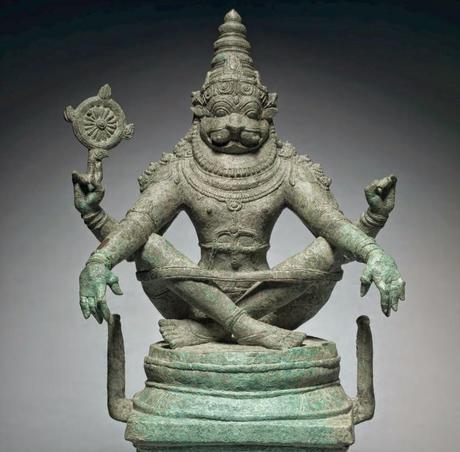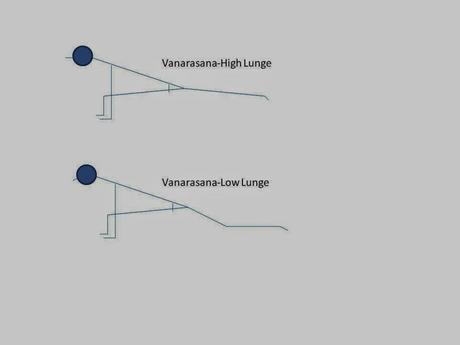
Hanuman as a Yogi
The terms Vanara, Markata, Khisha and Kapi all translate as: simian, monkey or ape. Hanuman, a vanara or ape-like humanoid, is one of the most important deities in Hindu mythology. Hanuman was an ardent devotee of Lord Rama and helped him by locating his wife Sita who was abducted by Ravana, the demon king. Hanuman is an epitome of physical strength, perseverance and devotion, and his personality reveals the limitless but dormant power within each one of us. His name derives from the Sanskrit words Hanu ("killed" or "destroyed") and maan (pride); thus, the name implies one who is devoid of pride and ego or one who has killed his pride and ego. Ruin and destruction closely follow on the heels of pride and ego. Despite possessing heroic qualities and unswerving faith and devotion towards Lord Rama, Hanuma had no sense of pride, arrogance or ego. \His exemplary qualities, including power, courage, humility, dedication, devotion and abject surrender to Lord Rama, are revered by one and all, earning him a pride of place among the numerous Hindu Gods. The Hatha Yoga Pradipika commemorates Hanuman with at least four poses (that I am aware of) dedicated to him. So today let’s explore not just Hanuman Asana but all the other poses dedicated to this ape-like-deity.Vanarasana
Most of us may not recognize this name even though we do this pose on a regular basis. In many yoga classes it is simply referred to as Lunge Pose (both high and low lunge constitute Vanarasana and the name primarily refers to the placement of the back leg). Vanarasana is done as a standalone pose or as part of the Sun Salutation series.

Low Lunge-Vanarasana: Without changing the placement of the hands and torso, lower your left leg and knee down towards the floor (resting your knee on a folded blanket, if needed). Keeping your right knee fixed in place and your torso over your front thigh, slide your left foot back until you feel a comfortable stretch in the left front thigh and groin. Turn the top of your left foot to the floor.
Repeat both versions of the pose on the other side.
Vanarsana opens the hips and chest and the pelvis, stretches the hip flexor muscles deep in the pelvis, strengthens the groin and legs and lengthens the spine. As you move into this pose, notice the pains that may accompany as you try to reach the maximum. If you feel physical pain at any time, modify the asana by backing off to the point where you do not experience any pain. This way, you can still get the benefit of the asana with suitable modifications. From Vanarasana, you can transition to Anjaneysana.
Anjaneyasana
As Hanuman was born to his mother Anjana, he is also known as Anjaneya (son of Anjana). This is also referred to as crescent moon pose. Like Vanarasana, Anjaneyasana is also done as a standalone pose or as part of the Sun Salutation series. While there are lot of similarities between Vanarasana and Anjaneyasana, the difference between the two poses is subtle and is primarily differentiated by the arm placement and position of torso. In Vanarasana both hands (or finger tips) are placed on the floor with the front knee sandwiched between the arms. In Anjaneyasana the arms are raised overhead and the torso is in an upright position. The back knee is either on the floor (Low Lunge-Anjaneyasana) or straightened back completely with the knee and hamstrings directed up toward the ceiling (High Lunge-Anjaneyasana). Similar to Vanarasana, Anjaneyasana strengthens the hamstrings, quadriceps, gluteus muscles and knees, opens the psoas and hips, improves balance, concentration and awareness and builds mental focus.
Both Anjaneyasana and Vanarasana provide us with an opportunity to express at least four of the many attributes that Hanuman possessed:
- Balam = Strength. Being strong in body and mind as well.
- Dhairya = Courage. Courage to dispel pride and ego and surrender to the divine within.
- Nirbhayatvam = Fearlessness. Without any fear, you attempt these poses to the extent that is right for your body.
- Bhakti = Devotion. If you attempt the poses with complete devotion to self, you will notice that the poses are no longer a fight to open the hips, hamstrings, psoas and other parts of the body but a pleasant effort at beefing up your inner capabilities.
This asana, in which your legs are split forward and back, requires significant physical flexibility. It stretches the hamstrings, groin and hip flexors, strengthens the pelvis and abdominal muscles. Those new to yoga or people with tight hips and hamstrings may find it difficult or impossible to get the legs and pelvis down on the floor. Use of suitable props is always advisable. Depending on how much support you need, try placing a block or thick bolster under the pelvis of your front leg. As you straighten your legs, slowly release your pelvis down onto the support. If the bolster is not comfortably supporting you, add a thickly folded blanket. If you have difficulty placing your hands on the floor, you may use blocks to support them.
You may experience two kinds of pain in Hanuman asana. If you experience physical pain, back off, and scale back temporarily or use the props I suggested. However, if you feel an emotional/mental pain building up either from your inability to do the splits or upon noticing that your neighbor is able to do it effortlessly, look inward, turn off the ego and close your eyes. In the yogic sense you are practicing pratyahara (using our senses with total/complete awareness). Wherever you are with this pose (partial, semi or full split), reign in your senses, turn your mind inward, use your breath to awaken the inner passion and notice how you are able to completely surrender into this pose, a quality that you can imbibe from Lord Hanuman.
This asana is of utmost spiritual significance, as well as requiring considerable physical flexibility. The pose alludes to Hanuman's famous leap from the mainland of India to the island of Sri Lanka to locate Rama’s wife Sita. The asana itself signifies the limitless power within us that helps to achieve even what may seem humanly impossible. More philosophically, it denotes complete openness and expansiveness of the heart, together with absolute faith and trust to succeed in our attempts. Whether you achieve the full split is not relevant; what is important is, can you let go of the pride and ego while attempting this pose? Thus, without the pride and ego and with full faith and devotion, you are able to go beyond your own capacity; this in itself is an act of submission to your own divinity.
Markatasana
This asana is reclined twist that is seldom described in books or magazines but it is commonly done especially after backbends. Lie on your back with your legs straight, toes and heels together and your arms in a T-position. Then, bend your knees, resting the soles of your feet on the ground, and draw your heels close to the buttocks. Now inhale and, keeping your legs stacked together, lower both legs over to the right. Drop your knees gently to the floor, keeping your pelvis on the floor, and twist your torso to left away from your legs (if it comfortable for you, you can also turn your head toward the left). Remain in this position for 4-5 breaths, exhale and come back to the starting position, keeping your legs together. Now repeat asana to the other side. Let go of any pride and ego, fill your heart with devotion towards self and notice the relaxation happening in the mind and body. The asana opens up the diaphragm, ribs and lungs. It stretches and strengthens the spinal cord and is thus helpful for backache and other spinal deformities.
While all of the above asanas dedicated to Lord Hanuman call for significant physical flexibility, they also remind us to perform to the best of our ability albeit letting go of any doubts and anticipation as to how it will be received. Judith Lasater said, “Yoga is not about touching your toes; it is about what you learn on the way down.” This adage applies to the monkey poses as well.
